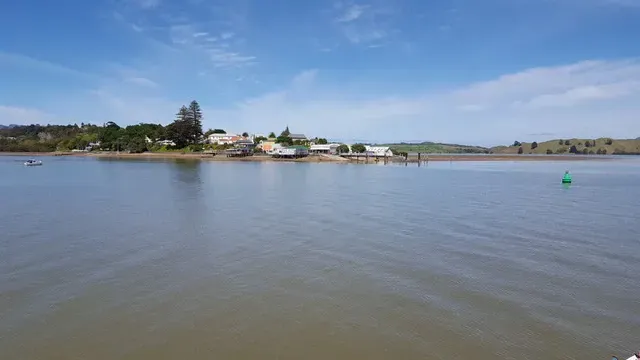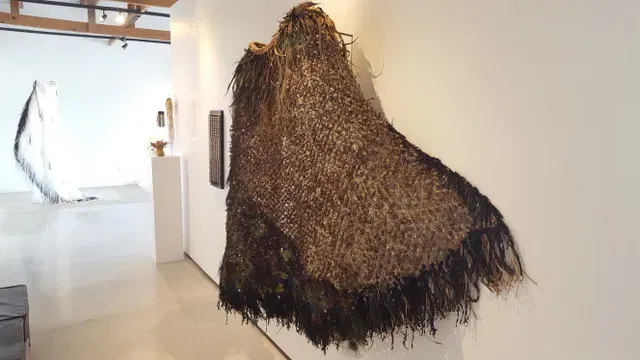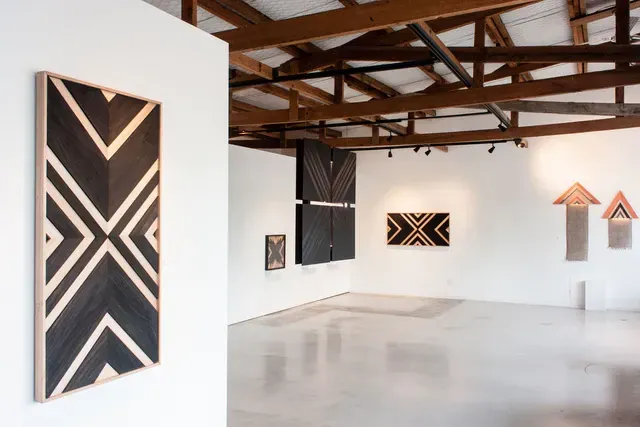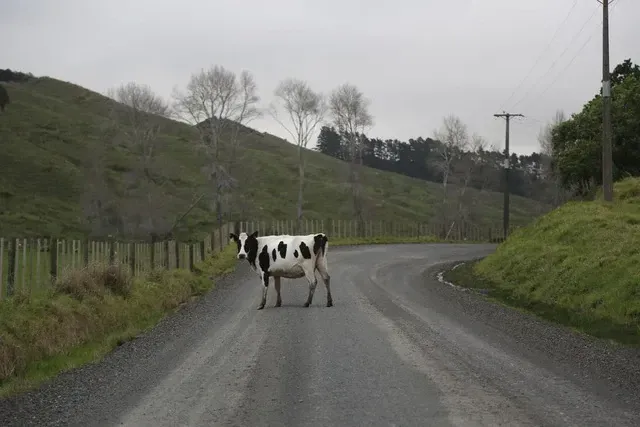On The Edges: Hokianga (part two)
Written by

This is part two of Mark Amery’s series on Hokianga, exploring the depth of character of the creative culture in this place. Last week, in On the edges: Hokianga (part one), Mark introduced the stories of three of the Hokianga’s artistic community: Heiwari Johnson, Lise Strathdee of Outpost Hokianga, and Liz McAuliffe.
We begin where we left off last week:
No.1 Parnell
In Auckland, Depot Artspace in Devonport has developed a strong model for a gallery as community, development, art and media space. They’ve brought that experience to bear in the establishment of gallery No.1 Parnell St in a historic shop in Rawene. Not shy of initiative, they’ve launched a Far North Art Award and held an artist residency last year. No.1 describe themselves as “a socially conscious community space celebrating and supporting sustainability in all creative fields”. That says a lot about their wish to meet local priorities. One of those is income generation through the sale of artwork, yet the market for good work will be largely elsewhere.
Lyn Lawton and Linda Blincko bought the building in a state of disrepair in 2013 and restored it.
“We were aware of how dynamic the arts were in the area. It seemed like a great opportunity to support local artists, and the local economy.
“Up here,” they write upfront, “there is an explicit understanding that the land, whenua, is a living entity - that its own being and presence informs the creative process. The arts seem more inspired by the environment, less self-conscious and overly cerebral somehow. A lot of exhibitions we have organised and hosted have had whenua as their focus: from the first community-initiated exhibition, No Drill, No Spill, protesting fracking in the Far North, a show on Kauri dieback, to the current Hebe Albrecht Highway to Hell exhibition which graphically depicts human abuse of the environment.
“The community is surrounded by and imbued with its primary source of inspiration and its continually changing patterns and moods; from the morning fog that settles on the harbour as a ghostly presence, to the sunsets that seem to wrap the land in gold foil.
“This community is very socially aware and politically active and the arts have been a great medium for education and protest.”
Galleries like theirs might inevitably be seen by some as part of outsider gentrification (Art of this World is also an offshoot of a Devonport gallery) but No.1 explicitly assert local values and provide wider community functions.
“It’s a privilege for us to have a small part to play in this community and we value the people and the environment they have so conscientiously maintained and protected. It’s a pleasure to celebrate this applied ethos at Number 1!”

Michelle Mayn – Weaver
Lise Strathdee notes the Hokianga as home to extraordinary weaving. One of our most acclaimed contemporary weavers Maureen Lander is from here, Rawene born. She is one of the mentors of Michelle Mayn.
Mayn is another used to splitting time between here and elsewhere - in her case New York, where she continues to study. She makes delicate weavings, sculptural objects and installations working with natural fibres. She studied traditional and contemporary Māori Weaving at Unitec in Auckland.
It’s the community as entrepreneurs that is special for her about the Hokianga. “Most services in the community are community-run by volunteers and they participate and input into decisions that affect the community through an email list called 'Vision Kohukohu'. A lot of people ask how I find the contest between New York and Kohukohu, and I think the unstoppable spirit and initiatives are very similar.”
“The Hokianga is incredibly beautiful with a close connection and relationship to the water. Ever changing light, the tranquil harbour and the distance from distractions of hectic city schedules make this an ideal place for me to focus on my work. The community is incredibly welcoming.”
Working with fibre the principal influence on her work have been established Māori artists Lander and Toi Te Maihi Rito.
“They are incredibly generous in sharing their knowledge and experience with others. This is an enormous support for me as an emerging artist.”
“The Hokianga’s remoteness is its charm and its challenge – encouraging tourists to incorporate this area in their travels as an art destination is an opportunity that is definitely there. Part of this challenge is the seasonal nature of tourism, the other is to continually improve the quality of art on offer so there is something to build that reputation on.”
Mayn’s ‘think big’ idea is for there to be a must-see destination through repurposing an old dairy factory as a contemporary art installation space. “Along the lines of the Dia Art Foundation in Beacon, New York or Mass MoCA in North Adams, Massachusetts. I could imagine a collection of works by Ralph Hotere who was born in the area with a rotating exhibition space for other works. No harm in dreaming big.”
Leona Kenworthy
Of new initiatives both Mayn and Strathdee single out the Hokianga Arts Community Trust’s container art project, due to open (final funding willing) in Opononi at Labour Weekend.
The project has been initiated by artist Leona Kenworthy with help from Jan Barratt. Kenworthy says one tension in an “income deprived” community is between the wish to provide a more experimental and development space for artists versus one where making sales is a priority.
“However, the Trust is also aware that there are two large and a few smaller venues for artists to sell work directly to the tourist market. We do not have a space where artists have the freedom to demonstrate innovation and experimentation… push the boundaries. For some artists the restraints are in the upfront costs in securing a venue. These might be works that won’t or don’t sell but promote the exchange of ideas and discussion.
“For these reasons the trust has a preference to ensure that both saleable and non-saleable contemporary art works and practices become the focus of the container. We want to encourage art and culture, artefacts and contributions from across the community.
“Additionally, we are looking at learning opportunities to be held at other local community venues. Examples might be to invite a curator to curate a show but they also might run a workshop and pass on their skills or have a residency. There are not always opportunities for people in this community to go to cities to access these things.”
Kenworthy emphasises that the art container will be an artist run space.
“By that we hope that it will be a path where many lines intersect, extend and disperse from. A space through which things emerge rather than begin or end. It won’t be a neat little packet… more messy and real, reactive to it's environment and dependent on the people and situations in relationship to this interface. It will take the form of our local landscape.”

Village Arts Gallery
Village Arts in Kohukohu is a much loved artist-run not-for-profit space supporting and inspiring the artists of Hokianga with curated shows and opportunities for local artists. It is run by a diverse collection of passionate artists, volunteers and supporters who keep the gallery open seven days a week all year.
Marg Morrow and Linda Montgomery believe its physical isolation here that inspires innovation.
“It has a beautiful unspoilt physical environment, with a strongly bi-cultural population and a large rural farming base. Our cheaper housing and space to work is a big attraction for cash-strapped urban artists.”
In terms of inspirations they mention Toi Te Rito Maihi and Sue Daly.
“Both women have given so much to our community. Toi inspires and encourages her weaving groups to explore contemporary issues through their artwork, and Sue, who introduced students to art history and the concepts and theories of contemporary art. Both have had a huge influence on Hokianga artists by encouraging a deeper appreciation of the world of art and its possibilities.”
Marg and Linda credit the five years that the Rawene branch of Northtec ran arts training as inspiring a new contemporary arts movement in Hokianga.
“It expanded the creative vision of our artists and opened a pathway to self-employment in the visual arts.”
“Now we have a good range of gallery spaces. What we would like to see in the future is the re-introduction of formal art education in Hokianga, mentoring opportunities to be made available, and the sponsorship and promotion of tutorial workshops and collective workspaces.
“A big challenge is encouraging and attracting more visitors to Hokianga to help keep our local arts economy buoyant. When visitors do travel the distance to get here they are overwhelmingly impressed by the quality of the work that is produced by our artists."

Denise Batchelor
Relocating to the area a year ago, Denise Batchelor is one of the most recent artists to land in the Hokianga. A still and moving image artist, getting increasing recognition nationally, her practice stems from a very intimate engagement with the world around her.
“Much of my work to date has focused on encounters with animalia, reflecting not only on moments in time but also an often-reciprocated experiential engagement, where I become both the observer and the observed. These experiences continue to inform my practice and shape my point of view, which is essentially that of an interconnected and interdependent world.”
“As the environment is such an integral element of my practice, where I live and base myself greatly influences my work. Looking back, my move to the Hokianga seems somewhat fated. This was a first for me, moving into a community where I did not know anyone. I had heard however that there was a large community of artists, artisans and musicians.”
“Like many artists, I tend to work alone and value uninterrupted time to research and focus on new work. My practice necessitates a durational approach, in preferably uninhabited environments bereft of the sounds of humanity. Living here has definitely allowed me these conditions and the diversity of the landscapes from forests to the harbour and wild west coast, provide infinite places to explore.”
“For me, this is a new beginning, one that has so far exceeded expectations.”


